I have some difficulties getting a specific curve to fit in R, while it works perfectly fine in a commercial curve-fitting program.
The formula that the data should fit to is:
y(t) = A * exp(-a*(t)) + B * exp(-b*(t)) - (A+B) * exp(-c*(t))
So for this I want to use the nonlinear regression built into R. I've been at this for a day on-and-off now and just can't get it to function. The issue lies entirely with the initial values, so I'm using NLS2 to brute-force find the initial values.
y <- c(0,0.01377,0.01400875,0.0119175,0.00759375,0.00512125,0.004175,0.00355375,
0.00308875,0.0028925,0.00266375)
t <- c(0,3,6,12,24,48,72,96,120,144,168)
df <- data.frame(t,y)
plot(t,y);
#Our model:
fo <- y ~ f1*exp(-k1*t)+f2*exp(-k2*t)-(f1+f2)*exp(-k3*t);
#Define the outer boundaries to search for initial values
grd <- data.frame(f1=c(0,1),
f2=c(0,1),
k1=c(0,2),
k2=c(0,2),
k3=c(0,0.7));
#Do the brute-force
fit <- nls2(fo,
data=df,
start = grd,
algorithm = "brute-force",
control=list(maxiter=20000))
fit
coef(fit)
final <- nls(fo, data=df, start=as.list(coef(fit)))
The values it should give are:
f1 0.013866
f2 0.005364
k1 0.063641
k2 0.004297
k3 0.615125
Though even with quite high iteration values, I'm just getting nonsense returns. I'm clearly doing something wrong, but I cannot see it
Edit based on @Roland 's comment:
The method you propose with the approximation of k1-3 with a linear approach seems to work on some datasets, but not on all of them. Below is the code I'm using now based on your input.
#Oral example:
y <- c(0,0.0045375,0.0066325,0.00511375,0.00395875,0.003265,0.00276,
0.002495,0.00231875);
t <- c(0,12,24,48,72,96,120,144,168);
#IV example:
#y <- c(0,0.01377,0.01400875,0.0119175,0.00759375,0.00512125,0.004175,
#0.00355375,0.00308875,0.0028925,0.00266375)
#t <- c(0,3,6,12,24,48,72,96,120,144,168)
DF <- data.frame(y, t)
fit1 <- nls(y ~ cbind(exp(-k1*t), exp(-k2*t), exp(-k3*t)), algorithm = "plinear", data = DF,
start = list(k1 = 0.002, k2 = 0.02, k3= 0.2))
k1_predict <-summary(fit1)$coefficients[1,1]
k2_predict <-summary(fit1)$coefficients[2,1]
k3_predict <-summary(fit1)$coefficients[3,1]
fo <- y ~ f1*exp(-k1*t)+f2*exp(-k2*t)-(f1+f2)*exp(-k3*t);
fit2 <- nls(fo, data = DF,
start = list(k1 = k1_predict, k2 = k2_predict, k3 = k3_predict, f1 = 0.01, f2 = 0.01))
summary(fit2);
plot(t,y);
curve(predict(fit2, newdata = data.frame(t = x)), 0, 200, add = TRUE, col = "red")
@G. Grothendieck Similar to Roland's suggestion, your suggestion is also excellent in that it is capable of fitting some datasets but struggles with others. The code below is based on your input, and exits with a singular gradient matrix.
#Oral example:
y <- c(0,0.0045375,0.0066325,0.00511375,0.00395875,0.003265,0.00276,
0.002495,0.00231875);
t <- c(0,12,24,48,72,96,120,144,168);
#IV example:
#y <- c(0,0.01377,0.01400875,0.0119175,0.00759375,0.00512125,0.004175,
#0.00355375,0.00308875,0.0028925,0.00266375)
#t <- c(0,3,6,12,24,48,72,96,120,144,168)
df <- data.frame(y, t)
grd <- data.frame(f1=c(0,1),
f2=c(0,1),
k1=c(0,2),
k2=c(0,2),
k3=c(0,0.7));
set.seed(123)
fit <- nls2(fo,
data=df,
start = grd,
algorithm = "random",
control = nls.control(maxiter = 100000))
nls(fo, df, start = coef(fit), alg = "port", lower = 0)
plot(t,y);
curve(predict(nls, newdata = data.frame(t = x)), 0, 200, add = TRUE, col = "red")
